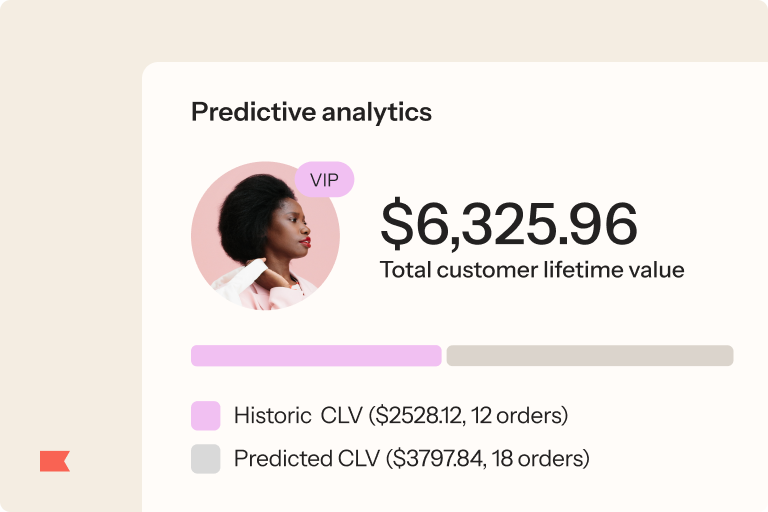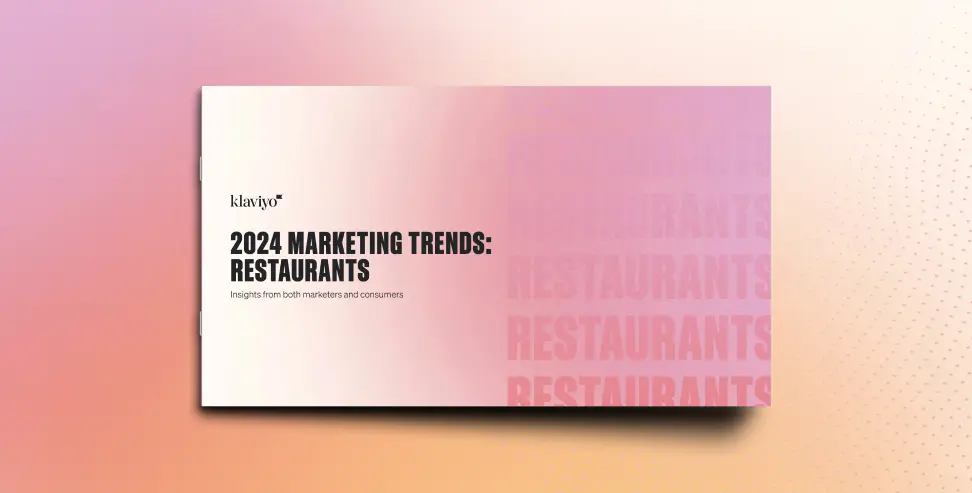4 new data-backed retention marketing strategies for restaurants in 2025
As if owning a restaurant isn’t hard enough, add economic uncertainty and the rising cost of ingredients into the mix and it might start feeling impossible to make a profit.
But we promise, there’s still good news to be had for the restaurant industry. To help restaurateurs get creative—and ultimately thrive during difficult times—Klaviyo surveyed 8,000+ restaurant consumers to ask them about their dining habits, spending decisions, and loyalty to the restaurants they love.
And while our data shows that restaurateurs will need to remain open to change to succeed, the good news is that there are plenty of evidence-based strategies to choose from to get to the same goal: more revenue.
According to Klaviyo’s 2025 restaurant marketing report, diners who join restaurant loyalty programs are 38% more likely than the general population to say they plan to increase their spending over the next 6 months. Those who are loyal to 5 or more restaurant brands, meanwhile, are nearly 3x times more likely (22%) to increase their restaurant spending than those who are not loyal to any (8%).
Considering more than half (51%) of consumers actively participate in restaurant loyalty or rewards programs, our official 2025 recommendation is to focus on diner retention and lifetime value rather than on costly acquisition strategiesthat may not yield a good return on investment.
Keep reading to find out exactly how you can maximize spend among your most loyal customers.
The data summary: 2025 restaurant marketing trends
Don’t let us keep you from the full 2025 restaurant marketing trends report—check it out if you want complete data on discovery patterns, purchasing decisions, brand relationships, and more.
But if you’re in a rush, here are the top 3 restaurant marketing trends from the report to inform your marketing strategy this year:
1. Loyal customers spend more, more frequently
Unsurprisingly, your most loyal diners are your most valuable ones. According to our research, loyalty program members are more likely to spend more per order ($100+) and dine more frequently (1x/week).
In addition to being 38% more likely than the general population to increase their restaurant spending over the next 6 months, active loyalty program members are also 100% more likely than non-loyalty members to increase their spending.
This is your signal to invest in the loyalty programs, mobile apps, and personalized offers that can drive more spending among loyal diners. And don’t be afraid to ask for the personal data necessary to make this possible—according to Klaviyo’s 2025 future of consumer marketing report, plenty of people are willing to share their contact information with restaurant brands in exchange for more personalized experiences.
2. High spenders are most likely to expect—and be influenced by—personalized experiences
Economic uncertainty leads, inevitably, to price sensitivity. Low spenders (those who spend $100 or less on an average order) are more likely to look for deals (24%), while high spenders (those who spend $100 or more) say they’ll reduce non-essential purchases instead (21%). And 10% of consumers have abandoned restaurant orders due to unexpected fees or taxes—a number that spikes to 16% for Gen Z.
But consumer personalization preferences present restaurateurs with the opportunity to be strategic about their discounts, rather than using blanket discounts to try to pull in new customers amid an uncertain economy.
High spenders, for example, care about personalization the most—they’re 29% more likely to be influenced by personalized dining recommendations based on their needs and interests than the general population. And loyalty program members are more likely than non-members to feel valued when restaurants offer exclusive offers or discounts that match their personal preferences (37% vs. 27%).
We know from our future of consumer marketing report that, overall, 74% of consumers expect more personalization from B2C brands in 2025. When diners feel like an offer is based on real interactions they’ve had with a restaurant, they’re more likely to return and spend more.
3. Mobile-first diners are your most valuable customers
Word of mouth still reigns supreme for discovery of new restaurants, especially in North America, according to our future of consumer marketing report.
That said, 45% of high spenders place orders via a restaurant’s mobile website—and loyalty program members are 115% more likely to use a restaurant’s mobile app to order (28%) than non-members (13%).
That means your restaurant may be leaving money on the table if you’re not investing in mobile optimization—and not just on your website, but across all digital channels.
Restaurant retention strategies: how to maximize spend among loyal diners
Email and SMS automations, targeted promotions, personalized content, and mobile optimization—these are all tools available to restaurateurs who may be rethinking their diner retention strategies in the face of an economic downturn.
Here’s how you can use these strategies to maximize spend and frequency among loyal customers.
1. Double down on automated loyalty messages
For restaurateurs who want to get started with automated loyalty messages, we recommend creating email and/or SMS flows that:
- Reward high-value behaviors (e.g., 2–3x weekly visits, $100+ orders).
- Reward VIPs for special occasions, like their birthday or anniversary.
- Re-engage lapsed members with personalized incentives based on previous spend or loyalty tier.
- Remind diners of their loyalty points or rewards they’ve earned—and their expiration date.
If you’re investing in a loyalty program, the key to encouraging repeat visits is to build an approach that goes beyond a punch card. Legal Sea Foods’ loyalty program is a masterclass in loyalty done right, offering the following perks:
- Free enrollment
- 1 point per dollar spent
- Tiered rewards
- 150 points: free cup of clam chowder
- 200 points: $10 reward
- 700 points: free lobster roll
- 1,700 points: lobster dinner for two
- Sign-up bonus: free clam chowder within 24 hours
- Birthday reward: free dessert

Image source: Legal Sea Foods
The program is the perfect blend of instant gratification and long-term goals. The free chowder upon sign-up gives an immediate taste of the rewards to come. The tiered system caters to both casual diners (with achievable lower-tier rewards) and loyal patrons (with the aspirational lobster dinner).
What we’re saying is that it’s not just a loyalty program—it’s a journey through the menu, encouraging customers to explore and indulge.
2. Run targeted promotions based on economic sensitivity
When your customer data lives in one place, you can create customer profiles that can tell you a lot about how and when to run promotions—and exactly to whom.
For example, if you’re seeing certain customers display economic sensitivity signals like low spending and buying only during promotions, you may want to give those customers what they want—personalized offers that reflect their price-sensitive dining habits—and highlight your higher-priced items for loyal customers who already spend more.
Tiered pricing can support a targeted promotional push based on economic sensitivity. If you run a steakhouse, for instance, you might send the following segmented promotions:
- Limited-time premium cuts (e.g., Wagyu ribeye) at market price to loyalty members who typically spend $100+
- A 10% discount on mid-range options (e.g., sirloin) to discount diners
- A budget-friendly menu (e.g., steak sandwiches) at a lower price point to diners who typically spend less
Another strategy is to create bundle deals that combine lower-margin items with high-margin bestsellers to protect average order value (AOV). That same steakhouse may combine a low-margin, high-cost item, like a premium cut of steak, with high-margin, low-cost items such as soup, dessert, and maybe an optional add-on for a glass of house wine—a very high-margin item.
3. Send personalized messages based on context
Personalized messages are personal because they reflect context. Now that we live so much of our lives online, we can only feasibly act on so many promotional messages from brands. When we do act, it’s likely because the message felt relevant to us in that moment.
This is the era of hyper-personalization, when restaurants need to be using real-time behavioral data to segment diners by spending level, loyalty program status, visit frequency, favorite menu items, and more. That’s what empowers you to connect with your guests in a way that reflects their actual wants and needs—and it’s how you generate revenue from fleeting opportunities.
Consider Svenfish, for example. The seafood brand started segmenting their customers based on the date of their most recent purchase, the number of purchases they’ve made, and their proximity to Svenfish’s new brick-and-mortar shop. The team now builds segments of customers who have shown interest in or bought whatever fish is fresh that morning, so they can send out targeted promotional campaigns that same day.
The result: hyper-personalized campaigns that improved discounting efficiency and reduced the number of customers going 3+ months between purchases.
4. Optimize mobile and app customer journeys
Remember, loyal customers and high spenders are more likely to shop with restaurants via mobile apps and websites. If you’re not following up a mobile visit with an SMS or a mobile push notification, you could be missing an opportunity to increase customer retention.
Mobile apps and loyalty programs are like peanut butter and jelly (or ice cream and olive oil, if that’s your preference). When someone takes an action in an app, you can match that action with a timed notification that can move them from casual customer to high-spend, high-frequency diner. If you do have an app, we recommend offering app-exclusive rewards that can increase dining frequency and AOV.
If you prefer to rely on your mobile site, you can still optimize it for mobile by using:
- Responsive design, meaning it adjusts based on the size of the device someone’s using to look at it
- Fast-loading images and multimedia
- Large, clickable buttons
- Simplified navigation
Here, see how Compass Coffee uses a responsive web design for the reviews page on their mobile site, featuring simple dropdown menus at the top to filter the reviews by topic, star rating, and whether or not the review contains media. The approach makes it easy for customers to view the types of reviews that will help them make a decision to buy.

Image source: Compass Coffee
Compass Coffee values reviews with photos so much that they incentivize customers to upload a photo in exchange for a discount. It’s a smart move: according to our future of consumer marketing report, customer reviews and/or feedback are the top consideration for diners across the board when choosing a new restaurant.
Retain customers and increase average order value with Klaviyo B2C CRM
With Klaviyo B2C CRM—the CRM built specifically for B2C businesses—restaurants are now able to consolidate their customer data, loyalty programs, email and SMS automations, customer service messages, and analytics in one place. With Klaviyo, restaurants can send targeted customer retention and loyalty offers with:
- Segmentation: Group diners based on preferences and real-time interactions with your restaurant brand. Target price-sensitive diners and high spenders with different messages, so you’re giving customers exactly what they want while protecting average order value.
- Automatic email and SMS: Make money in your sleep and send messages automatically when diners take a certain action or meet certain loyalty thresholds.
- Loyalty program integrations: Connect your customer data with no-code loyalty program integrations that make full use of what you know about your most frequent customers.
- Built-in AI: Use AI to more easily build audience segments, write messages, and understand sentiment across customer reviews.


Related content

See how Customer Hub, Customer Agent, and Helpdesk powered faster support, reduced tickets, and boosted revenue during Klaviyo Service’s first BFCM.

Post-purchase experiences are where customer loyalty begins. Learn how to automate and personalize them to grow your B2C brand

Discover how lifecycle marketing transforms your CRM into a growth engine, driving retention, automation, and personalized B2C customer experiences.
